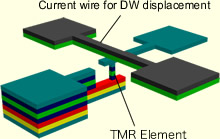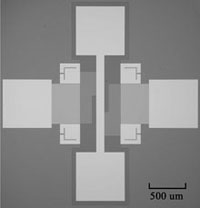![]()
Giant magnetoresistance (GMR) magnetic field sensors have been widely used in many applications such as hard-disk-drive heads, linear/rotary position sensing, and biomagnetic sensing. Compared to various other magnetic sen- sors, the GMR sensor has a high-frequency response, over 1 MHz, and can be easily integrated onto one chip. However, typical GMR sensors show lower field resolution than other sensors such as fluxgate and magneto-impedance sensors. Most of the spin-valve GMR sensors only utilize the rotation of free-layer magnetization to detect the external magnetic field. For this type of sensors, a bias field is applied to saturate the free-layer magnetization along the easy axis and the external field is detected along the hard axis. |
Illustration of domain wall displacement type TMR sensor
Microfabricated DWD type GMR sensor |
| paper: | Y. Hashimoto et al., J. Appl. Phys. 123, 113903 (2018). |


